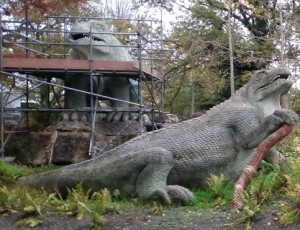Crystal Palace Dinosaurs get Grade 1 Listed Monument Status
In a move welcomed by dinosaur fans young and old the famous Crystal Palace sculptures of prehistoric animals have been granted Grade 1 Listed Monument status by the Dept. of Culture, Media and Sport.
The sculptures of prehistoric animals including Iguanodon, Megalosaurus and Hylaeosaurus (some of the first dinosaurs to be named and described), were originally built for the re-opening of the Crystal Palace in 1854. The original location for the Crystal Palace had been London’s Hyde Park which, in 1851 was converted into an Victorian theme park highlighting the achievements of the era – The Great Exhibition, the centrepiece of which was the enormous 22 acre glass pavilion – the Crystal Palace.
The task of building huge models of prehistoric animals to populate the landscaped gardens around the glass pavilion was given to Benjamin Waterhouse Hawkins. Sir Richard Owen was appointed to oversee the works to ensure they were sculpted accurately.
Although we know far more about the anatomy and posture of these animals, at the time these models depicted the very latest scientific knowledge. They were the CGI models of the Victorian era. Certainly, Hawkin’s sculptures were immense and it was an achievement to have them built and erected. A contemporary description of the construction of the Iguanodon states “some thirty-five feet long with four iron columns, nine feet long, seven inches in diameter, 600 bricks, 650 five-inch drain tiles, 900 plain tiles and 90 casks of broken stone”.
By the time the permanent Crystal Palace exhibition was opened on June 10th 1854, dinomania had swept the country and over 40,000 spectators came to see the new statues of these prehistoric animals. As well as the dinosaurs, models were also built of mammals, pterosaurs and marine lizards such as the Plesiosaurs. In recognition of the work done on these animals by English scientists (aided most notably by Mary Anning).
These unique sculptures, now over 150 years old were first granted Grade Two Listing in 1973, but the recent Government ruling puts them into the same category as other famous monuments such as Buckingham Palace, Windsor Castle and Eton College. Grade 1 Listing is the highest, only buildings or monuments of outstanding historical or architectural importance are awarded this status. This should permit the sculptures to receive funding for repairs and other work from English Heritage.
An Iguanodon 1850’s Style
As accurate representations of the real animals, they have a lot to be desired but they depict the remarkable progress made in the science of palaeontology and our understanding of prehistoric animals in the 153 years since they first went on show to the public. The new Grade 1 status should ensure their preservation, the earliest attempts to reconstruct a prehistoric world, safeguarded for future generations.
The sculptures are also testament to the bitter rivalry between Sir Richard Owen and Gideon Mantell. Mantell, an extremely gifted scientist had described the fore-limbs of Iguanodon as being more slender than the hind-limbs. He had proposed that they might have been used for grasping and gathering vegetation as well as locomotion. Sir Richard Owen, always scornful of Mantell’s work overruled him, preferring to give the sculptures the elephantine stance that his own descriptions favoured.
We now believe that Mantell was right. However, this does not stop dinosaurs being depicted in different ways. Below are two models of Iguanodon (I. bernissartensis), one modelled under the direction of the London Natural History museum, the second modelled under the direction of the Museum of Stuttgart.
Same dinosaur, but different depiction.
Dinosaur Models: Dinosaur and Prehistoric Animal Models.







Leave A Comment